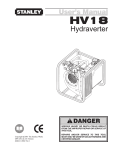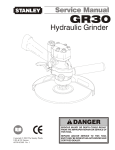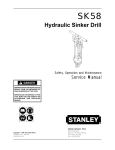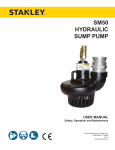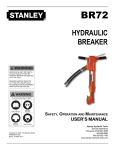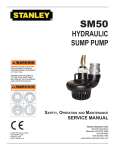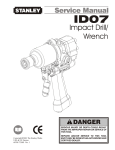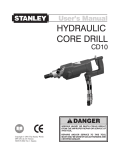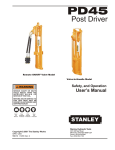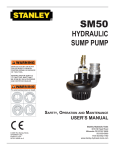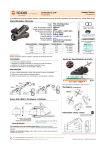Download SM50 Service Manual
Transcript
® Service Manual SM50 Hydraulic Sump Pump DANGER SERIOUS INJURY OR DEATH COULD RESULT FROM THE IMPROPER REPAIR OR SERVICE OF THIS TOOL. Copyright c 2002 The Stanley Works OPS USA & CE Version 60915 8/2003 Ver. 1 REPAIRS AND/OR SERVICE TO THIS TOOL MUST ONLY BE DONE BY AN AUTHORIZED AND CERTIFIED DEALER. Table of Contents SM50 Hydraulic Sump Pump SERVICING THE SM50 Sump Pump: This manual contains Safety, Operation, and Troubleshooting information. Stanley Hydraulic Tools recommends that servicing of hydraulic tools, other than routine maintenance, must be performed by an authorized and certified dealer. Please read the DANGER warning on the cover and the Copyright c 2002 The Stanley Works All rights reserved. Under copyright law, this document may not be copied in whole or in part without the prior written consent of The Stanley Works. This exception does not permit copies to be made for others, whether or not sold. Under the law, copying includes translating into another language, format or medium. This copyright notice must appear on any permitted copies. Certificate of Conformity 4 Specifications 4 General Safety Instructions 5 Tool Decals and Tags 5 Hydraulic Hose Requirements 7 HTMA Requirements 8 Operating Instructions 9 Troubleshooting 11 Maintenance 13 Service Instructions 14 Parts Illustration 17 Parts List 18 Warranty 19 SAFETY FIRST It is the responsibility of the operator and service technician to read rules and instructions for safe and proper operation and maintenance. A cautious worker using common sense is the greatest safety device. 3 Certificate of Conformity I, the undersigned: Mellits, Kirk E. Surname and First Names hereby certify that the construction plant or equipment specified hereunder: 1. Category: Sump Pump 2. Make: Stanley 3. Type: SM50 4. Type Serial Number of equipment: 5. Year of manufacture: Stamped on tool ALL has been manufactured in conformity with- EEC Type examination as shown: Directive: EN 809 Approved body: Self Date: 1992 Date of expiration: N/A 6. Special Provisions: Done at: None Stanley Hydraulic Tools, Milwaukie, Oregon USA Date: 2002 Position: Engineering Manager Signature: Specifications Weight______________________ 20 lbs. / 9.1 kg Overall Length________________ 10 in. / 25.4 cm Width________________________10 in. 25.4 cm Pressure Range_____1000-2000 psi / 70- 140 bar Flow Range_____________7-12 gpm / 26-45 lpm System Type____ Open Center, HTMA TYPE 2, 3 Porting______________________ -8SAE O-Ring Couplers_________________ HTMA Flush Face HTMA Class II_____________7-9 gpm @ 2000 psi 26 - 34 lpm @ 138 bar Per NFPA T3.20.15/ISO 16028 HTMA Class III__________11-13 gpm @ 2000 psi 42-49 lpm @ 138 bar Water Outlet Size______________3.0 in. / 7.6 cm 30Lpm at 138bar BHTMA CATEGORY EHTMA Category______30 lpm @ 138 bar 40Lpm at 138bar EHTMA CATEGORY EHTMA Category______40 lpm @ 138 bar Sound Pressure______________<85 dBA @ 1 m Vibration_____________________________N/A 4 General Safety Instructions Always observe safety symbols. They are included for your safety and the protection of the tool. WARNING DANGER This safety symbol may appear on the tool. It is used to alert the operator of an action that could place him/her or others in a life threatening situation. This safety symbol appears in these instructions to identify an action that could cause bodily injury to the operator or other personnel. CAUTION This safety symbol appears in these instructions to identify an action or condition that could result in damage to the tool or other equipment. This tool will provide safe and dependable service if operated in accordance with the instructions given in this manual. Read and understand this manual and any stickers and tags attached to the tool and hoses before operation. Failure to do so could result in personal injury or equipment damage. A Operator must start in a work area without bystanders. The operator must be familiar with all prohibited work areas such as excessive slopes and dangerous terrain conditions. A Establish a training program for all operators to ensure safe operations. A Do not operate the tool unless thoroughly trained or under the supervision of an instructor. A Always wear safety equipment such as goggles, head protection, and safety shoes at all times when operating the tool. A Do not inspect or clean the tool while the hydraulic power source is connected. Accidental engagement of the tool can cause serious injury. A Do not operate this tool without first reading the Operating Instructions. A Do not install or remove this tool while the hydraulic power source is connected. Accidental engagement of the tool can cause serious injury. A Never operate the tool if you cannot be sure that underground utilities are not present. Underground electrical utilities present an electrocution hazard. Underground gas utilities present an explosion hazard. Other underground utilities may present other hazards. A Do not wear loose fitting clothing when operating the tool. Loose fitting clothing can get entangled with the tool and cause serious injury. A Supply hoses must have a minimum working pressure rating of 2500 psi/175 bar. A Be sure all hose connections are tight. A The hydraulic circuit control valve must be in the “OFF” position when coupling or uncoupling the tool. Wipe all couplers clean before connecting. Failure to do so may result in damage to the quick couplers and cause overheating. Use only lint-free cloths. A Do not operate the tool at oil temperatures above 140° F/60° C. Operation at higher oil temperatures can cause operator discomfort and may cause damage to the tool. A Do not operate a damaged, improperly adjusted, or incompletely assembled tool. A To avoid personal injury or equipment damage, all tool repair, maintenance and service must only be performed by authorized and properly trained personnel. A Do not exceed the rated limits of the tool or use the tool for applications beyond its design capacity. A Always keep critical tool markings, such as labels and warning stickers legible. A Always replace parts with replacement parts recommended by Stanley Hydraulic Tools. A Check fastener tightness often and before each use daily. 5 Tool Decals & Tags A Name Tag Sticker is attached to the tool. Never exceed the flow and pressure levels specified on this sticker.The information listed on the name tag sticker must be legible at all times. Replace this sticker if it becomes worn or damaged. A replacement is available from your local Stanley distributor. Stanley Hydraulic Tools ® CAUTION 3810 S.E. Naef Road Milwaukie, Oregon 97267 U.S.A. Model No. 26-45 lpm/7-12 gpm SM50 138 bar/2000 psi 4-12 GPM/ 15-43 LPM DO NOT EXCEED 2000 PSI/ 140 BAR 30Lpm at 138bar BHTMA CATEGORY 40Lpm at 138bar BHTMA CATEGORY HTMA TYPE II HTMA TYPE III 52728 SM50 Combined Sticker DANGER The SAFETY TAG, P/N 15875, shown at right, smaller than actual size, is attached to the tool when shipped from the factory. Read and understand the safety instructions listed on this tag before removal. We suggest you retain this tag and attach it to the tool when not in use. 6 DANGER 1. FAILURE TO USE HYDRAULIC HOSE LABELED AND CERTI-FIED AS NON-CONDUCTIVE WHEN USING HYDRAULIC TOOLS ON OR NEAR ELECTRICAL LINES MAY RESULT IN DEATH OR SERIOUS INJURY. BEFORE USING HOSE LABELED AND CERTIFIED AS NON- CONDUCTIVE ON OR NEAR ELECTRIC LINES. BE SURE THE HOSE IS MAINTAINED AS NON- CONDUC TIVE . THE HOSE SHOULD BE REGULARLY TESTED FOR ELECTRIC CURRENT LEAKAGE IN ACCORDANCE WITH YOUR SAFETY DEPARTMENT INSTRUCTIONS. 2. A HYDRAULIC LEAK OR BURST MAY CAUSE OIL INJECTION INTO THE BODY OR CAUSE OTHER SEVERE PERSONAL INJURY. A.DO NOT EXCEED SPECIFIED FLOW AND PRESSURE FOR THIS TOOL. EXCESS FLOW OR PRESSURE MAY CAUSE A LEAK OR BURST. B. DO NOT EXCEED RATED WORKING PRESSURE OF HYDRAULIC HOSE USED WITH THIS TOOL. EXCESS PRESSURE MAY CAUSE A LEAK OR BURST. C. C H E C K T O O L , H O S E , C O U P L E R S & C O N N E C T O R S D A I L Y F O R LEAKS. DO NOT FEEL FOR LEAKS WITH YOUR HANDS. CONTACT WITH A LEAK MAY RESULT IN SEVERE PERSONAL INJURY. D. DO NOT LIFT OR CARRY TOOL BY THE HOSES. DO NOT ABUSE HOSE. DO NOT USE KINKED, TORN OR DAMAGED HOSES. 3. MAKE SURE HYDRAULIC HOSES ARE PROPERLY CONN-ECTED TO THE TOOL BEFORE PRESSURIZING SYSTEM. SYSTEM PRESSURE HOSE MUST ALWAYS BE CONNECTED TO TOOL “IN” PORT. SYSTEM RETURN HOSE MUST ALWAYS BE CONNECTED AT TOOL “OUT” PORT. REVERSING CONNECTIONS MAY CAUSE REVERSE TOOL OPERATION WHICH CAN CAUSE SEVERE PERSONAL INJURY. 4. DO NOT CONNECT CLOSED-CENTER TOOLS TO OPEN-CENTER HYDRAULIC SYSTEMS. THIS MAY CAUSE EXTREME SYSTEM HEAT AND/OR SEVERE PERSONAL INJURY. DO NOT CONNECT OPEN-CENTER TOOLS TO CLO SE D- CE NT ER HYDRAULIC SYSTEMS. THIS MAY RESULT IN LOSS OF OTHER HYDRAULIC FUNCTIONS POWERED BY THE SAME SYSTEM AND/OR SEVERE PERSONAL INJURY. 5. BYSTANDERS MAY BE INJURED IN YOUR WORK AREA. KEEP BYSTANDERS CLEAR OF YOUR WORK AREA. 6. WEAR HEARING, EYE, FOOT, HAND AND HEAD PROTECTION. 7. TO AVOID PERSONAL INJURY OR EQUIPMENT DAMAGE, ALL TOOL REPAIR, MAINTENANCE AND SERVICE MUST BE PERFORMED BY AUTHORIZED AN D PR OP ER LY TRAINED PERSONNEL. IMPORTANT IMPORTANT READ OPERATION MANUAL AND SAFETY INSTRUCTIONS FOR THIS TOOL BEFORE USING IT. READ OPERATION MANUAL AND SAFETY INSTRUCTIONS FOR THIS TOOL BEFORE USING IT. USE ONLY PARTS AND REPAIR PROCEDURES APPROVED BY STANLEY AND DESCRIBED IN THE OPERATION MANUAL. USE ONLY PARTS AND REPAIR PROCEDURES APPROVED BY STANLEY AND DESCRIBED IN THE OPERATION MANUAL. TAG TO BE REMOVED ONLY BY TOOL OPERATOR. (517) SEE OTHER SIDE 15875 TAG TO BE REMOVED ONLY BY TOOL OPERATOR. (517) SEE OTHER SIDE 15875 Hydraulic Hose Requirements HOSE TYPES Hydraulic hose types authorized for use with Stanley Hydraulic Tools are as follows: Certified non-conductive Wire-braided (conductive) Fabric-braided (not certified or labeled non-conductive) Hose listed above is the only hose authorized for use near electrical conductors. Hoses and listed above are conductive and must never be near electrical conductors. HOSE SAFETY TAGS To help ensure your safety, the following DANGER tags are attached to all hoses purchased from Stanley Hydraulic Tools. DO NOT REMOVE THESE TAGS. If the information in a tag is illegible because of wear or damage, replace the tag immediately. A new tag may be obtained at no charge from your Stanley Distributor. This Tag attached to “Certified Non-Conductive” hose. DANGER DANGER 1. FAILURE TO USE HYDRAULIC HOSE LABELED AND CERTIFIED AS NON-CONDUCTIVE WHEN USING HYDRAULIC TOOLS ON OR NEAR ELECTRIC LINES MAY RESULT IN DEATH OR SERIOUS INJURY. FOR PROPER AND SAFE OPERATION, MAKE SURE THAT YOU HAVE BEEN PROPERLY TRAINED IN CORRECT PROCEDURES REQUIRED FOR WORK ON OR AROUND ELECTRIC LINES. 4. HANDLE AND ROUTE HOSE CAREFULLY TO AVOID KINKING, ABRASION, CUTTING OR CONTACT WITH HIGH TEMPERATURE SURFACES. DO NOT USE IF KINKED. DO NOT USE HOSE TO PULL OR LIFT TOOLS, POWER UNITS, ETC. 5. CHECK ENTIRE HOSE FOR CUTS, CRACKS, LEAKS, ABRASIONS, BULGES OR DAMAGE TO COUPLINGS. IF ANY OF THESE CONDITIONS EXIST, REPLACE THE HOSE IMMEDIATELY. NEVER USE TAPE OR ANY DEVICE TO ATTEMPT TO MEND THE HOSE. 2. BEFORE USING HYDRAULIC HOSE LABELED AND CERTIFIED AS NON-CONDUCTIVE ON OR NEAR ELECTRIC LINES, WIPE THE ENTIRE LENGTH OF THE HOSE AND FITTINGS WITH A CLEAN, DRY, ABSORBENT CLOTH TO REMOVE DIRT AND MOISTURE AND TEST HOSE FOR MAXIMUM ALLOWABLE CURRENT LEAKAGE IN ACCORDANCE WITH SAFETY DEPARTMENT INSTRUCTIONS. 6. AFTER EACH USE, STORE IN A CLEAN, DRY AREA. 3. DO NOT EXCEED HOSE WORKING PRESSURE OR ABUSE HOSE. IMPROPER USE OR HANDLING OF HOSE COULD RESULT IN BURST OR OTHER HOSE FAILURE. KEEP HOSE AS FAR AWAY AS POSSIBLE FROM BODY AND DO NOT PERMIT DIRECT CONTACT DURING USE. CONTACT AT THE BURST CAN CAUSE BODILY INJECTION AND SEVERE PERSONAL INJURY. SEE OTHER SIDE SEE OTHER SIDE Side 1 Side 2 DO NOT REMOVE THIS TAG DO NOT REMOVE THIS TAG (shown smaller than actual size) p/n 27987 This Tag attached to “Conductive” hose. DANGER DANGER 1. DO NOT USE THIS HYDRAULIC HOSE ON OR NEAR ELECTRIC LINES. THIS HOSE IS NOT LABELED OR CERTIFIED AS NON-CONDUCTIVE. USING THIS HOSE ON OR NEAR ELECTRIC LINES MAY RESULT IN DEATH OR SERIOUS INJURY. 5. CHECK ENTIRE HOSE FOR CUTS, CRACKS, LEAKS, ABRASIONS, BULGES OR DAMAGE TO COUPLINGS. IF ANY OF THESE CONDITIONS EXIST, REPLACE THE HOSE IMMEDIATELY. NEVER USE TAPE OR ANY DEVICE TO ATTEMPT TO MEND THE HOSE. 2. FOR PROPER AND SAFE OPERATION, MAKE SURE THAT YOU HAVE BEEN PROPERLY TRAINED IN CORRECT PROCEDURES REQUIRED FOR WORK ON OR AROUND ELECTRIC LINES. 6. AFTER EACH USE, STORE IN A CLEAN, DRY AREA. 3. DO NOT EXCEED HOSE WORKING PRESSURE OR ABUSE HOSE. IMPROPER USE OR HANDLING OF HOSE COULD RESULT IN BURST OR OTHER HOSE FAILURE. KEEP HOSE AS FAR AWAY AS POSSIBLE FROM BODY AND DO NOT PERMIT CONTACT DURING USE. CONTACT AT THE BURST CAN CAUSE BODILY INJECTION AND SEVERE PERSONAL INJURY. 4. HANDLE AND ROUTE HOSE CAREFULLY TO AVOID KINKING, ABRASION, CUTTING OR CONTACT WITH HIGH TEMPERATURE SURFACES. DO NOT USE IF KINKED. DO NOT USE HOSE TO PULL OR LIFT TOOLS, POWER UNITS, ETC. SEE OTHER SIDE SEE OTHER SIDE Side 1 Side 2 DO NOT REMOVE THIS TAG DO NOT REMOVE THIS TAG (shown smaller than actual size) p/n 29144 HOSE PRESSURE RATING The rated working pressure of the hydraulic hose must be equal to or higher than the relief valve setting on the hydraulic system. 7 HTMA Requirements Tool Category C Hydraulic System Requirements 20Lpm at 138bar BHTMA CATEGORY 30Lpm at 138bar BHTMA CATEGORY Type I Type II 40Lpm at 138bar EHTMA CATEGORY Type III 4-6 gpm 7-9 gpm 10.5-11.6 gpm 11-13 gpm (15-23 lpm) (26-34 lpm) (36-44 lpm) (42-49 lpm) 2000 psi 2000 psi 2000 psi 2000 psi (138 bar) (138 bar) (138 bar) (138 bar) System relief valve setting 2100-2250 psi 2100-2250 psi 2100-2250 psi 2100-2250 psi (at the power supply outlet) (145-155 bar) (145-155 bar) (145-155 bar) (145-155 bar) Maximum back pressure 200 psi 200 psi 200 psi 200 psi (at tool end of the return hose) (14 bar) (14 bar) (14 bar) (14 bar) Measured at a max. fluid viscosity of: 400 ssu* 400 ssu* 400 ssu* 400 ssu* (82 centistokes) (82 centistokes) (82 centistokes) (82 centistokes) 140° F (60° C) 140° F (60° C) 140° F (60° C) 140° F (60° C) 3 hp (2.24 kW) 40° F (22° C) 5 hp (3.73 kW) 40° F (22° C) 6 hp (4.47 kW) 40° F (22° C) 7 hp (5.22 kW) 40° F (22° C) 25 microns 18 gpm (68 lpm) 25 microns 25 microns 25 microns 30 gpm (114 lpm) 35 gpm (132 lpm) 40 gpm (151 lpm) Flow rate Tool Operating Pressure (at the power supply outlet) (at min. operating temperature) Temperature Sufficient heat rejection capacity to limit max. fluid temperature to: (at max. expected ambient temperature) Min. cooling capacity at a temperature difference of between ambient and fluid temps NOTE: Do not operate the tool at oil temperatures above 140° F (60° C). Operation at higher temperatures can cause operator discomfort at the tool. Filter Min. full-flow filtration Sized for flow of at least: (For cold temp. startup and max. dirt-holding capacity) Hydraulic fluid Petroleum based (premium grade, anti-wear, non-conductive) Viscosity (at min. and max. operating temps) 100-400 ssu* 100-400 ssu* 100-400 ssu* 100-400 ssu* (20-82 centistokes) (20-82 centistokes) (20-82 centistokes) (20-82 centistokes) NOTE: When choosing hydraulic fluid, the expected oil temperature extremes that will be experienced in service determine the most suitable temperature viscosity characteristics. Hydraulic fluids with a viscosity index over 140 will meet the requirements over a wide range of operating temperatures. NOTE: These are general hydraulic system requirements. See tool Specification page for tool specific requirements. 8 Operating Instructions performance. 1. Connect a hose fitted with a 3 in. / 76.2 mm female camlock coupler to the pump outlet fitting. Make sure the fitting is securely tightened. CAUTION Observe the following for Equipment protection and care. Pre-operation Procedures 2. Lower the pump into the liquid to be pumped. Locate the outlet end of the discharge hose to disperse the liquid as required. Remove any kinks from the hose to assure maximum water flow. Check Power Source 1. Using a calibrated flow meter and pressure gauge, check that the hydraulic power source develops a flow of 7-12 gpm / 26-45 lpm at 1000-2000 psi / 70-140 bar. WARNING Never Point the end of the hose at bystanders. 2. Make certain that the power source is equipped with a relief valve set to crack at 2100 psi / 145 bar maximum. 3. Energize the power source. Watch for solids in the liquid being pumped. If solids are excessive, the discharge flow may decrease. If this happens, stop the pump and check for the cause of the problem. 3. Check that the pump inlet screen and outlet hose are clean. Remove any obstruction before operating the pump. Refer to PUMP CLEANING PROCEDURES. Under some conditions, the liquid being pumped may be slowed enough so that it can no longer push particles in the liquid. If this happens, particles can accumulate in the hose and back up to the pumping chamber, causing further restriction. The impeller then acts as a "grinding wheel" which causes accelerated pump wear. Reduced liquid flow can be caused by the following: Connect Hoses 1. Wipe all hose couplers with a clean, lint free cloth before making connections. 2. Connect the hoses from the power supply to the tool fittings. It is a good practice to connect return hoses first and disconnect last to minimize or avoid trapped pressure within the tool. 3. If hose couplers are used, observe the arrow on the coupler to ensure that the flow is in the proper direction. The female coupler on the tool port is the inlet pressure coupler. This coupler should be connected to the port closest to the water outlet. Pump Operation Note: The SM50 pump is NOT DESIGNED FOR USE WITH A SUCTION PIPE INLET. The diameter of the suction screen at the bottom of the pump provides maximum pump efficiency. Reducing the size of this inlet will greatly reduce pump 9 ! The pump sinks into solids at the bottom of the hole. ! The end of the outlet hose is too high, causing excessive lift height for the column of liquid being pushed by the pump. This slows the flow of liquid to a level where it can no longer carry solids out the hose end. ! The flow and pressure of hydraulic oil to the pump is too low which reduces impeller speed. A 20 percent decrease in hydraulic oil flow can reduce pump performance by 50 percent. When operating at reduced hydraulic flow and pressure, the end of the outlet hose should not be more than 30 feet above the Operating Instructions liquid. 4. When pumping is completed, set the hydraulic flow control valve at the power source to OFF, then lift the pump from the hole or chamber. Cold Weather Operation If the pump is to be used during cold weather, preheat the hydraulic oil at low engine speed prior to use, when using the normally recommended oils, oil should be at or above 50°F / 10°C (400 ssu / 82 centistokes) before use. Damage to the hydraulic system or pump can result from the use with oil that is too viscous or thick. 10 Troubleshooting This section describes how to find and resolve problems users may experience. If a situation occurs that is not covered, call your Stanley Customer Service representative for assistance. WARNING Inspecting the tool or installing parts with the hydraulic hoses connected can result in severe personal injury or equipment damage. To prevent accidental startup, disconnect the hydraulic power before beginning any inspection or installation task. If symptoms of poor performance develop, the following chart can be used as a guide to correct the problem. When diagnosing faults in operation of the tool, always check that the hydraulic power source is supplying the correct hydraulic flow and pressure to the tool as listed in the table. Use a flowmeter known to be accurate. Check the flow with the hydraulic oil temperature at least 80° F/27° C. Symptom Pump will not start. Possible Cause No hydraulic flow or pressure. Defective couplers. Impeller jammed with debris. Poor pump performance. Solution Turn on power unit and check that 7-12 gpm / 26-45 lpm at 1000-2000 psi / 70-140 bar is available at the pump. Check the couplers. Replace, if necessary. Clean the pumping chamber as described in the MAINTENANCE section of the manual. Defective hydraulic motor. Repair or replace motor. Hydraulic flow reversed. Check that hoses are correctly connected to the pump motor ports. The pressure hose should be connected to the IN port. The return oil must never flow through a reversing valve. Check that 7-12 gpm / 26-45 lpm at 1000-2000 psi / 70 -140 bar is available at the pump. A 20 percent decrease in flow can result in a 50 percent decrease in pump performance. Lift the pump from the bottom of the hole or chamber. Use a flat support under the pump if necessary. Low hydraulic oil flow. Pump submersed in sediment. Pump inlet restricted. Remove the suction screen and clean thoroughly. Reassemble. continued 11 Troubleshooting Symptom Poor pump performance. (continued) Possible Cause Discharge hose kinked or restricted. Solution Straighten the hose. If hose must bend at top of hole, use a bend of split rigid conduit with a diameter large enough to accept the diameter of the expanded hose. This will keep the hose from kinking. Check for debris inside the hose. Clean as required. Discharge hose too small. Water lift too high for gpm supply from hydraulic power source. Use 3 in./ 76.2 mm diameter fire hose. Lower the outlet end of the discharge hose. Increase hydraulic flow (12 gpm / 45 lpm max.) Pump not matched to application. Obtain higher capacity pump. Impeller worn or damaged. Check for impeller damage and excessive wear. Replace the impeller if necessary. Remove. Use no plumbing on suction side of pump. Hose used on suction side of pump. Poor pump performance with excessive wear. Too many solids in the water. Water speed out of the hose may be too slow, therefore hose and pump load up with solids. 12 Reduce solids content. Increase pump speed. Maintenance WARNING Inspecting the tool or installing parts with the hydraulic hoses connected can result in severe personal injury or equipment damage. To prevent accidental startup, disconnect the hydraulic power before beginning any inspection or installation task. Cleaning the Pumping Chamber Debris such as weeds, sand and other solids may become trapped in the water hose and pumping chamber. This can reduce pump performance. It is important that the pumping chamber be kept clean at all times. The chamber can be cleaned as follows: 4. Assemble the motor and impeller to the volute. Clean the capscrews and lubricate the threads with underwater grease before installation. 5. Remove all debris from the hose. Otherwise, solids will backfill the pump. 1. Remove motor and impeller by removing the two M12 x 1.75 Hex Head capscrews. 2. Remove all debris from the pump screen. 3. Thoroughly clean the volute and impeller. Do not remove the impeller unless necessary for repair or replacement or to remove trapped debris. 13 Service Instructions Tool Disassembly / Reassembly Note: For orientation of parts in the following procedures, refer to the parts drawing later in this manual. 1. Remove the hex socket head capscrews (33) that secure the motor cap (31) to the front bearing housing (24) and remove the motor cap. Do not in any way excessively force the motor cap off the front bearing housing. Prior to Disassembly 2. Remove the o-ring (26) from the motor cap. 1. Clean the exterior of the tool and place on a clean work surface. Drive Shaft 2. Obtain the seal kit listed on the PARTS LIST so all seals exposed during disassembly can be replaced. 1. Remove idler gear (29), idler shaft (30), drive gear (28), and needle roller (19) from front bearing housing. Prior to Reassembly 2. Remove the v-ring (6) from the seal race (14) before pulling the seal race off the drive shaft. 1. Clean all parts with a degreasing solution 3. Remove retaining ring (9). 2. Blow dry all parts or use lint-free cloths. 3. Ensure that all seals exposed during disassembly are replaced with new parts. 4. Using a pick, remove the seal carrier (10), cup seal (12), o-ring (11), seal retainer (13), and o-ring (15) from the bearing cavity. 4. Apply clean grease or o-ring lubricant to all parts during assembly. 5. Press the drive shaft (17) and bearings (16) from the front bearing housing. Tool Disassembly 6. Spin the ball bearings on the drive shaft. The bearing should turn smoothly. To replace the bearing, support the outer race and press down on the drive shaft from the threaded end. Do not reuse the ball bearing once it has been removed from the drive shaft. Volute 1. Remove the volute (1) by first removing the hex head cap screws (25) and pulling the motor and impeller off the volute. Drive Shaft Seal Impeller 1. Remove hex socket head capscrew (3) and washer (4) before lifting impeller (5) off motor assembly. 1. Remove the retaining ring (20), quad ring (21), seal gland (22) and o-ring (23) from the drive shaft bore using a pick. Cleaning and Inspection 2. Remove key (18) and shim stack (7 & 8) from impeller. Cleaning Motor Cap Clean all parts with a degreasing solution. Blow dry with compressed air or use lint-free cloths. 14 Service Instructions Gear Chamber (Motor Cap) Tool Reassembly The chamber bores and bottoms around the shaft bushings should be polished and not rough or grooved. If the bushing bores are yellow-bronze, replace them and investigate the cause of wear. Drive Shaft Seal 1. Heavily lubricate and install a new o-ring (23) and quad ring (21) into seal gland (22). Ensure the quad ring is not twisted during assembly. The flat surfaces around the chamber and bolt holes should be flat and free of nicks or burrs that could cause misalignment or leaks. 2. Install seal gland and attached parts into front bearing housing and secure with retaining ring (20). Bushings Drive Shaft The inside of the bushings should be gray with some bronze showing through. If significant yellowbronze shows, replace the bushings. Inspect the motor shaft and idler shaft for corresponding wear and replace as required. 1 Install bearings (16) onto lubricated drive shaft (17) by supporting the inner races of the bearings and pressing drive shaft through bearings until the bearings rest against the shoulder. Installation by the outer race will cause bearing damage. Gears 2. Pack grease into needle roller groove on drive shaft and insert drive shaft into the seal gland. Using a bearing pusher or a sleeve / socket with a diameter slightly smaller than the bearing bore, press the bearing assembly into place using the outer race. Installation by the inner race will result in bearing damage. The drive and idler gears should have straight tips without nicks, square tooth ends, and a smooth even polish on the teeth and end faces. Replace the gear if cracks are present. Front Bearing Housing 3. Lubricate and install o-ring (15) and seal race (14) onto driveshaft. The surface near the gears should show two interconnecting polished circles without a step. 4. Lubricate and install seal retainer (13) and o-ring (11) into bearing bore. Shafts The shaft diameter at the bearing and seal locations must be smooth. Grooves, roughness or a reduced diameter indicate fluid contamination or damaged bushings. Grit particles may have been imbedded in the bushings, grinding into the hardened shaft. If abnormal shaft wear as noted above occurs (more than normal polishing), replace both the shaft and associated bushings. 5. Heavily lubricate with underwater grease and install cup seal (12) and seal carrier (10) into bearing bore and secure with retaining ring (9). Installation of seal carrier and cup seal before seal race has been installed will result in damage to cup seal. Also check the hydraulic system for excess contamination in the fluid and for filter condition. Operating conditions may require changing from a 25-micron filter to an oversized 10-micron filter. 7. Install idler shaft (30) and idler gear (29). 6. Lubricate with underwater grease and install v-ring (6) onto seal race. 8. Use grease to hold needle roller (19) in place before installing drive gear (28). 15 Service Instructions Motor Cap Volute 1. Lubricate and install o-ring (26) into motor cap (31). 1. Assemble motor and impeller to volute (1) and secure with hex head cap screws (25). 2. Lubricate hex socket head capscrews (33) with an antiseize compound and install motor cap to front bearing housing. Tighten capscrews to 8-10 ft.lb. Note the orientation of the motor cap as the bolt holes will only line up one way. 2. Use an allen wrench to ensure that the impeller with freewheel after assembly. CAUTION Do not force parts together. Impeller 1. Install shim stack (7&8) onto drive shaft. 2. Install key (18) and impeller (5) to drive shaft and, using loctite, secure with washer (4) and hex socket head capscrew (3). Tighten capscrew to 15 ft.lb. 3. Using a depth mic, measure the distance from the bottom of the motor flange to the bottom of the stepped diameter as shown below. Adjust shim stack accordingly to achieve a 2.285 / 2.270 offset. 16 SM50 Parts Illustration 35 36 19 17 34 18 16 33 15 14 13 31 12 32 11 10 30 9 6 29 28 8 27 7 5 26 2 25 4 3 24 1 23 22 21 20 17 SM50 Parts List NOTE: Use Part Number and Description when ordering. Accessories 59101 Adapter, 2-1/2 Inch Male NPT /3 Inch Male Groove Item Part 1 2 3 4 5 6 7 8 9 10 11 12 13 14 15 16 17 18 19 20 21 22 23 24 25 26 27 28 29 30 31 32 33 34 35 36 18 Description Qty. 52669 52720 13815 56763 52671 52716 31032 31033 00166 52719 01262 58651 56658 56697 01211 00148 52696 00635 06881 00170 00669 19884 00171 52693 52718 00178 06316 06853 06855 06854 06857 52728 00612 00936 24058 24059 Volute Camlock Coupling 3 in. HSHCS 5/16 - 18 x 3/4 Washer Impeller V-Ring Shim .020 Shim .010 Retaining Ring Seal Carrier O-ring 1-3/4 x 1-7/8 x 1/16 -031 Cup Seal Seal Retainer Seal Race O-ring 5/8 x 3/4 x 1/16 -016 Bearing Drive Shaft Key Needle Roller Retaining Ring Quad Ring 1/2 x 5/8 x 1/16 - 014 Seal Gland O-Ring 11/16 x 13/16 x 1/16 - 017 Front Bearing Housing HHCS M12-1.75 x 30mm O-ring 2-1/8 x 2-1/4 x 1/16 - 034 Bushing Drive Gear Idler Gear Idler Shaft Gear Housing Name Tag and Safety Sticker HSHCS 1/4-20 x 2-1/4 Adapter Flush Face Coupler Body 3/8 NPT Flush Face Coupler Nose 3/8 NPT 1 1 1 1 1 1 * * 1 1 1 1 1 1 1 2 1 1 1 1 1 1 1 1 2 1 2 1 1 1 1 1 8 2 1 1 52758 Repair Kit 00148 00635 06881 13815 56763 52759 Bearing Key Needle Roller HSHCS Washer Seal Kit 52759 Seal Kit 00171 00178 00669 01211 01262 19884 52716 58651 O-Ring 11/16 x 13/16 x 1/16 - 017 O-ring 2-1/8 x 2-1/4 x 1/16 - 034 Quad Ring 1/2 x 5/8 x 1/16 - 014 O-ring O-ring Seal Gland V-Ring Cup Seal 2 1 1 1 1 1 1 1 1 1 1 1 1 1 Warranty Stanley Hydraulic Tools (hereinafter called “Stanley”), subject to the exceptions contained below, warrants new hydraulic tools for a period of one year from the date of sale to the first retail purchaser, or for a period of 2 years from the shipping date from Stanley, whichever period expires first, to be free of defects in material and/or workmanship at the time of delivery, and will, at its option, repair or replace any tool or part of a tool, or new part, which is found upon examination by a Stanley authorized service outlet or by Stanley’s factory in Milwaukie, Oregon to be DEFECTIVE IN MATERIAL AND/OR WORKMANSHIP. EXCEPTIONS FROM WARRANTY NEW PARTS: New parts which are obtained individually are warranted, subject to the exceptions herein, to be free of defects in material and/or workmanship at the time of delivery and for a period of 6 months after the date of first usage. Seals and diaphragms are warranted to be free of defects in material and/or workmanship at the time of delivery and for a period of 6 months after the date of first usage or 2 years after the date of delivery, whichever period expires first. Warranty for new parts is limited to replacement of defective parts only. Labor is not covered. FREIGHT COSTS: Freight costs to return parts to Stanley, if requested by Stanley for the purpose of evaluating a warranty claim for warranty credit, are covered under this policy if the claimed part or parts are approved for warranty credit. Freight costs for any part or parts which are not approved for warranty credit will be the responsibility of the individual. SEALS & DIAPHRAGMS: Seals and diaphragms installed in new tools are warranted to be free of defects in material and/or workmanship for a period of 6 months after the date of first usage, or for a period of 2 years from the shipping date from Stanley, whichever period expires first. CUTTING ACCESSORIES: Cutting accessories such as breaker tool bits are warranted to be free of defects in material and or workmanship at the time of delivery only. ITEMS PRODUCED BY OTHER MANUFACTURERS: Components which are not manufactured by Stanley and are warranted by their respective manufacturers. a. Costs incurred to remove a Stanley manufactured component in order to service an item manufactured by other manufacturers. ALTERATIONS & MODIFICATIONS: Alterations or modifications to any tool or part. All obligations under this warranty shall be terminated if the new tool or part is altered or modified in any way. NORMAL WEAR: Any failure or performance deficiency attributable to normal wear and tear such as tool bushings, retaining pins, wear plates, bumpers, retaining rings and plugs, rubber bushings, recoil springs, etc. INCIDENTAL/CONSEQUENTIAL DAMAGES: To the fullest extent permitted by applicable law, in no event will STANLEY be liable for any incidental, consequential or special damages and/or expenses. FREIGHT DAMAGE: Damage caused by improper storage or freight handling. LOSS TIME: Loss of operating time to the user while the tool(s) is out of service. IMPROPER OPERATION: Any failure or performance deficiency attributable to a failure to follow the guidelines and/or procedures as outlined in the tool’s operation and maintenance manual. MAINTENANCE: Any failure or performance deficiency attributable to not maintaining the tool(s) in good operating condition as outlined in the Operation and Maintenance Manual. HYDRAULIC PRESSURE & FLOW, HEAT, TYPE OF FLUID: Any failure or performance deficiency attributable to excess hydraulic pressure, excess hydraulic back-pressure, excess hydraulic flow, excessive heat, or incorrect hydraulic fluid. REPAIRS OR ALTERATIONS: Any failure or performance deficiency attributable to repairs by anyone which in Stanley’s sole judgement caused or contributed to the failure or deficiency. MIS-APPLICATION: Any failure or performance deficiency attributable to mis-application. “Mis-application” is defined as usage of products for which they were not originally intended or usage of products in such a matter which exposes them to abuse or accident, without first obtaining the written consent of Stanley. PERMISSION TO APPLY ANY PRODUCT FOR WHICH IT WAS NOT ORIGINALLY INTENDED CAN ONLY BE OBTAINED FROM STANLEY ENGINEERING. WARRANTY REGISTRATION: STANLEY ASSUMES NO LIABILITY FOR WARRANTY CLAIMS SUBMITTED FOR WHICH NO TOOL REGISTRATION IS ON RECORD. In the event a warranty claim is submitted and no tool registration is on record, no warranty credit will be issued without first receiving documentation which proves the sale of the tool or the tools’ first date of usage. The term “DOCUMENTATION” as used in this paragraph is defined as a bill of sale, or letter of intent from the first retail customer. A WARRANTY REGISTRATION FORM THAT IS NOT ALSO ON RECORD WITH STANLEY WILL NOT BE ACCEPTED AS “DOCUMENTATION”. NO ADDITIONAL WARRANTIES OR REPRESENTATIONS This limited warranty and the obligation of Stanley thereunder is in lieu of all other warranties, expressed or implied including merchantability or 19 For additional Sales & Service information, contact: ® Stanley Hydraulic Tools Division of the Stanley Works 3810 SE Naef Road Milwaukie, OR 97267 USA Tel: (503) 659-5660 Fax: (503) 652-1780




















